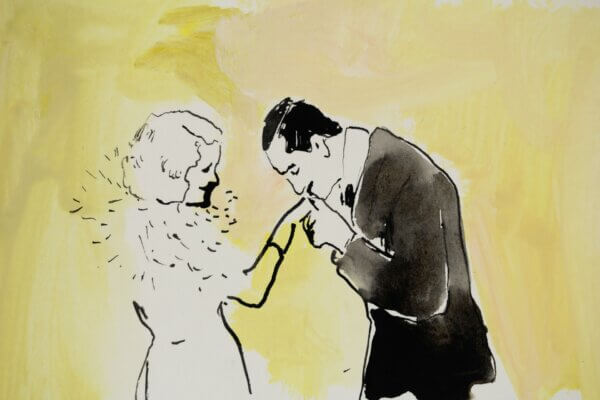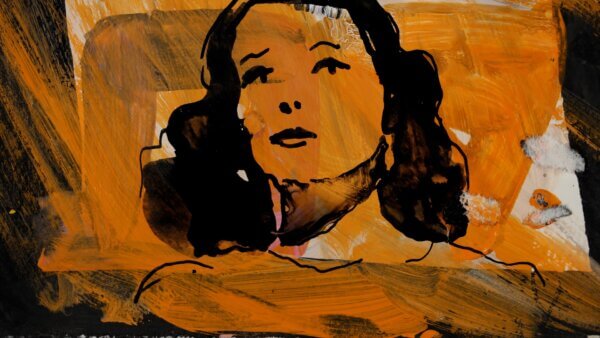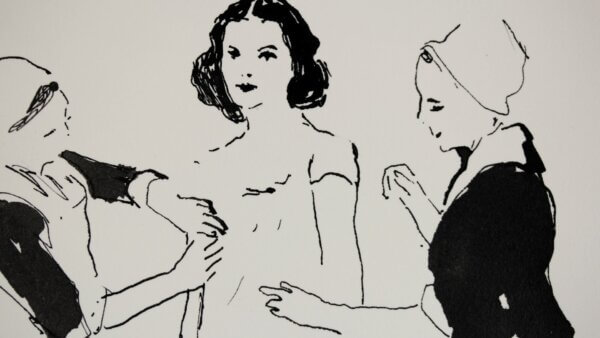The Debutante | Interview with Director Elizabeth Hobbs
The Debutante by Elizabeth Hobbs is an experimental tour de force based on the partially biographical writing of the British-born surrealist artist Leonora Carrington. Hobbs’s new film takes the uptight world of 1930s debutante society and imbues it with an impish sense of wild freedom. Created and funded in collaboration with Animate Projects and the BFI Short Form Animation Fund, the stunning work by BAFTA-nominated animator Lizzy Hobbs is a remarkable expression of avant-garde filmmaking, that radiates the power of its radical feminist narrative. This synergy between medium and subject can be seen in a mixed-media approach that combines collage, 2D, ink, paint and rotoscoping. Aided by a core team of editor Mark Jenkins, composer Hutch Demouilpied and Abigail Addison of Animate Projects, the film has journeyed far and wide screening at over 100 festivals, picking up multiple awards in its wake and was shortlisted for an Academy Award nomination last year.
Ahead of the 2024 British Animation Awards, in which the film is up for the Best Short Film award, we spoke to a long-time friend of Skwigly Lizzy Hobbs about her past, present and future creative intentions and what it is to presume creative freedom and independent thinking in the auteur filmmaking landscape.
Where did you study and what was your journey into animation?
I did a foundation year at Chelsea College of Art, then I went to Edinburgh College of Art to study Illustration. After I graduated I really got into printmaking, thanks to the Edinburgh Printmaker’s Workshop, and printed small editions of artists’ books for 10 years. I made my first animation while I was doing a Postgraduate Diploma in Electronic Imaging in Dundee around 1999.
What prompted you to move into moving imagery?
I was printing and binding these small editions of prints and artists’ books, sometimes only 10 copies of each. I was able to sell them to museums and galleries, including New York Public Library, Museum of Modern Art, New York, but I could only show them to a few people before they were no longer pristine enough to sell. I was also keen to try and expand my storytelling options, and I was very attracted to the darkness and drama of the cinema, as well as the ability to add sound and humour through timing and movement, so animation was a really exciting next step.
So presumably, narrative was a big part of your art practice before moving into animation as well?
Yes, I’ve always loved storytelling. Although that wasn’t the only part of the process that I carried over from my printmaking practice into animation, I try to retain a combination of the experimental and methodical in my attitude to animation, and I always try to respond to the materials possibilities of the medium. In that way I don’t think you can become bored or run out of ideas.
The Debutante was based on a short story written by the artist, Leonora Carrington. Can you tell me a bit about her and how you came across her work originally?
I knew a bit about Leonora Carrington, I admired her feminism, and her surrealist paintings, and then five years ago I read her short story called The Debutante. I didn’t even know that Leonora Carrington wrote short stories. I was really struck by it, I just couldn’t believe how bold it was. She wrote the story in 1938, in French, which wasn’t her first language, and in translation it has a bald syntax that sort of really tells it without any fanfare. I just loved it. It’s semi-autobiographical; she had also been presented as a debutante at the court of George V, and didn’t want to go down the route of being married. She escaped with Max Ernst to France and then wrote this story based on her experience of that.

Still from The Debutante by Lizzy Hobbs
What were the circumstances? Did you have to make contact with Leonora Carrington’s estate in order to get permission to make the film?
I first contacted the Leonora Carrington Estate in 2016. I wrote them a letter saying I really loved the story and was there any chance I could adapt it for animation. They initially didn’t want to, they were very polite, but they didn’t want an adaptation. I kept in touch with them and then when I got the BAFTA nomination for I’m OK in 2018 I thought perhaps having made a successful film about the artist Kokoschka would reassure them that I wasn’t going to do anything that would be detrimental to her memory. It maybe wasn’t to do with that, but they said yes, and at the same time Abigail Addison from Animate Projects came on board and we were lucky enough to get BFI funding to go into production.
So the film, like many of your previous films, has a new experimental process, this time incorporating elements of rotoscoping. Your work is always so expressive and fresh, what was new or unique for you on this project?
Thank you, I included rotoscoping because I wanted the film to feel like it was set in 1938, when it was written, so that the story makes more sense. It’s important that we are embedded in the world of smart clothes, grand houses and a social occasion in which you have to get everything just right. Only then can we appreciate the surreal contrast with the smelly hyena in the zoo and the chaos that she brings to the event.
There’s a real joy and freedom to your work. Why is experimentation so important to you as an animator?
Oh, good question. I love talking about that! I think for me animating can be a bit boring if you know exactly how everything is going to turn out from the beginning. Robert Breer made a suggestion that when he was about to animate he experienced a heightened awareness, which I really resonate with. It feels like an excited readiness. So I always tried to make something that is a bit surprising for me as well as other people. I usually try to see what I can manage without and try to capture it all in the moment, under the rostrum. You could make The Debutante film in a hundred different ways, every animator would do it differently and it’s so good that I think it would always make a great film, but in my adaptation I wanted to recognise the wildness in the story so that it really kind of shines out of the image, this shocking, joyful story that she’s written.
I find that interesting, like you say, because everybody approaches filmmaking – particularly animation – differently. Obviously, you had the text you were basing the film on but when you first approached a film like this, what comes into your mind? Do you come to a film with a kind of visual idea or any kind of motif or any scenes? Or is it very much based on text and mood or energy?
It’s a really good comment, because sometimes when I’m working with students who are making an important film to them, they often procrastinate with scripts and storyboards, and I ask “Is there something you can just put down? A place that you can start, an image or animated sequence that you really like so you can just dive into it?” (alongside the important work of storyboards and animatics!)
Funnily enough, in this story, there’s this scene in which a bat comes in the room from outside and she jumps behind the sofa. And that was the image that I had in my mind for ages. I kept animating it. And actually, it didn’t make it into the film and everything else became kind of more exciting as I was going along. But this bat and her behind the sofa was originally quite a key moment that I was focused on. As I made the film, she became a bit bigger and a bit more powerful. And her cowering behind the sofa didn’t work in the end.

Still from The Debutante by Lizzy Hobbs
The film was made in collaboration with Animate Projects and with the BFI Short Form Animation Fund – what was the process like from application to final delivery?
It’s always brilliant to have the chance to work with Abigail Addison at Animate Projects. We applied as a team for the first round of the BFI Short Form Animation Fund. It opened for applications just as we had been given permission to use the story. Abigail was really excited by Leonora Carrington’s The Debutante as well and we had worked together on a few films before, so we were in a good position to apply. The fund allowed us to work with my long term collaborator, the editor Mark Jenkins, who brings a lot of story rigour, and then we were able to work with composer Hutch Demouilpied. She was a really fantastic addition to the team, she has so many ideas, especially on the theme of radical women, which was a really wonderful aspect of this project. We could work with three brilliant actors, and Fonic, who always bring high quality and creative sound design. We wouldn’t have been able to do all of that without the BFI funding. I’m not sure how high priority animation production funding is in the UK at the moment, so we were really glad that the film was received so well. The film travelled to over 100 festivals, was shortlisted for an Academy Award, as well as picking up many awards including at Clermont-Ferrand and SXSW. It proves that there is a great appetite and appreciation for narrative animations, even if they are on the experimental side of things.
So did you use an animatic in order to pitch?
Yes, I find it quite hard but I did manage to produce an animatic. I worked with it the whole production, popping in the new scenes and sending the cuts up to Mark Jenkins in Orkney. Hutch Demouilpied composed what she termed ‘brushstrokes’ for us to work with as well. So the animatic was quite a loose and creative document but it functioned well, and in this case it didn’t change wildly because the story had this quite clear structure already. I put off the dinner scene until the end, because I knew that was going to be really hard, all those people eating and screaming and shouting. So I worked from the beginning forwards.
So you’re a very busy person? How do you fit filmmaking around everything else you’re involved with? Or does everything else sort of fit around the filmmaking?
Actually I’m not so busy at the moment, I have a nice balance. I have a lovely job as senior lecturer at NFTS for 2 days a week, and I have 2 or 3 studio days. I’m collaborating on a new piece with composer Carola Bauckholt, who I made The Flounder with, we are making something for live performance next year. At the same time I’m also developing a new short film of my own, hopefully with Animate Projects, which might be ready in around 2025.
The 2024 British Animation Awards take place at the BFI Southbank Thursday March 7th.
For more on the work of Elizabeth Hobbs visit lizzyhobbs.wordpress.com


